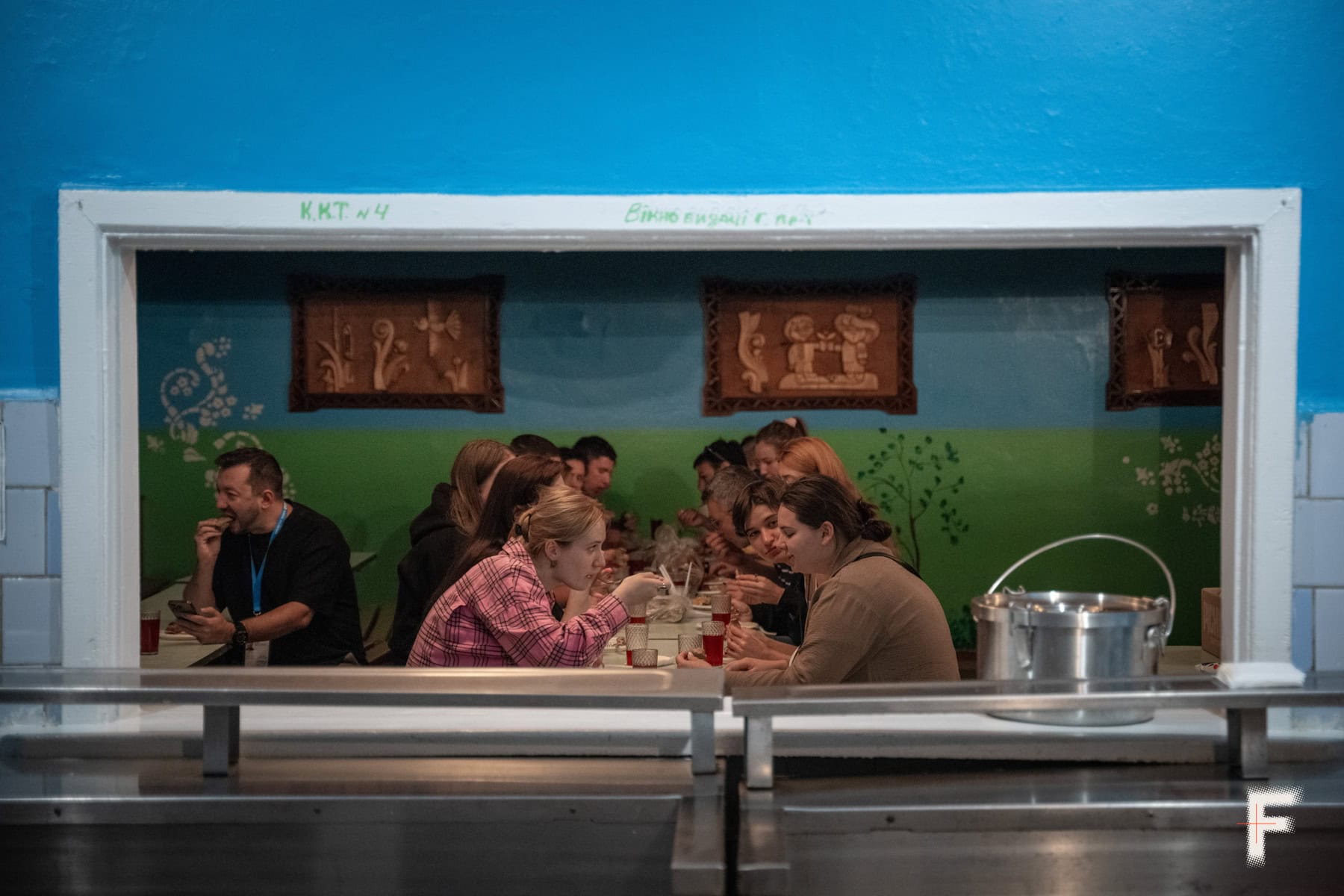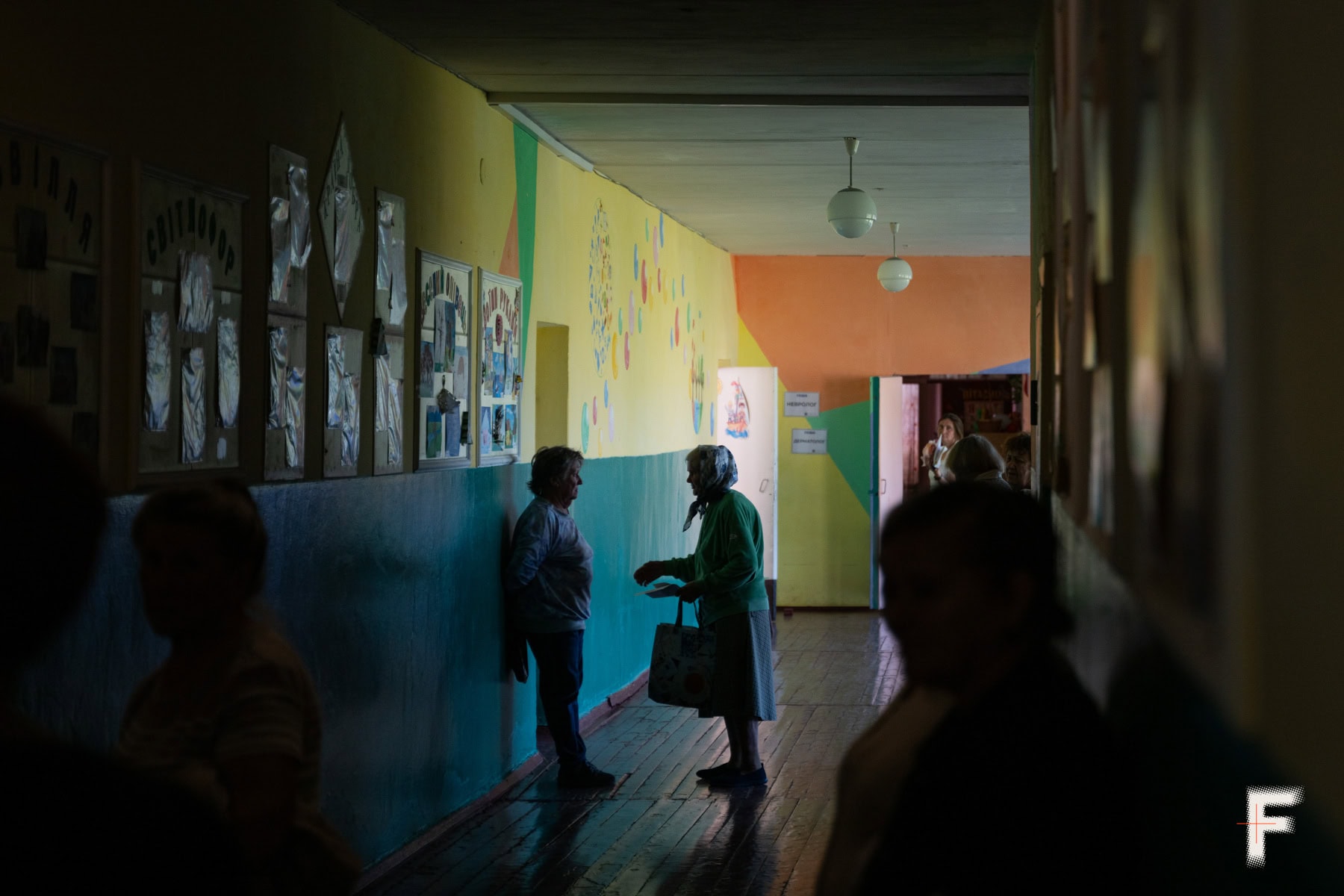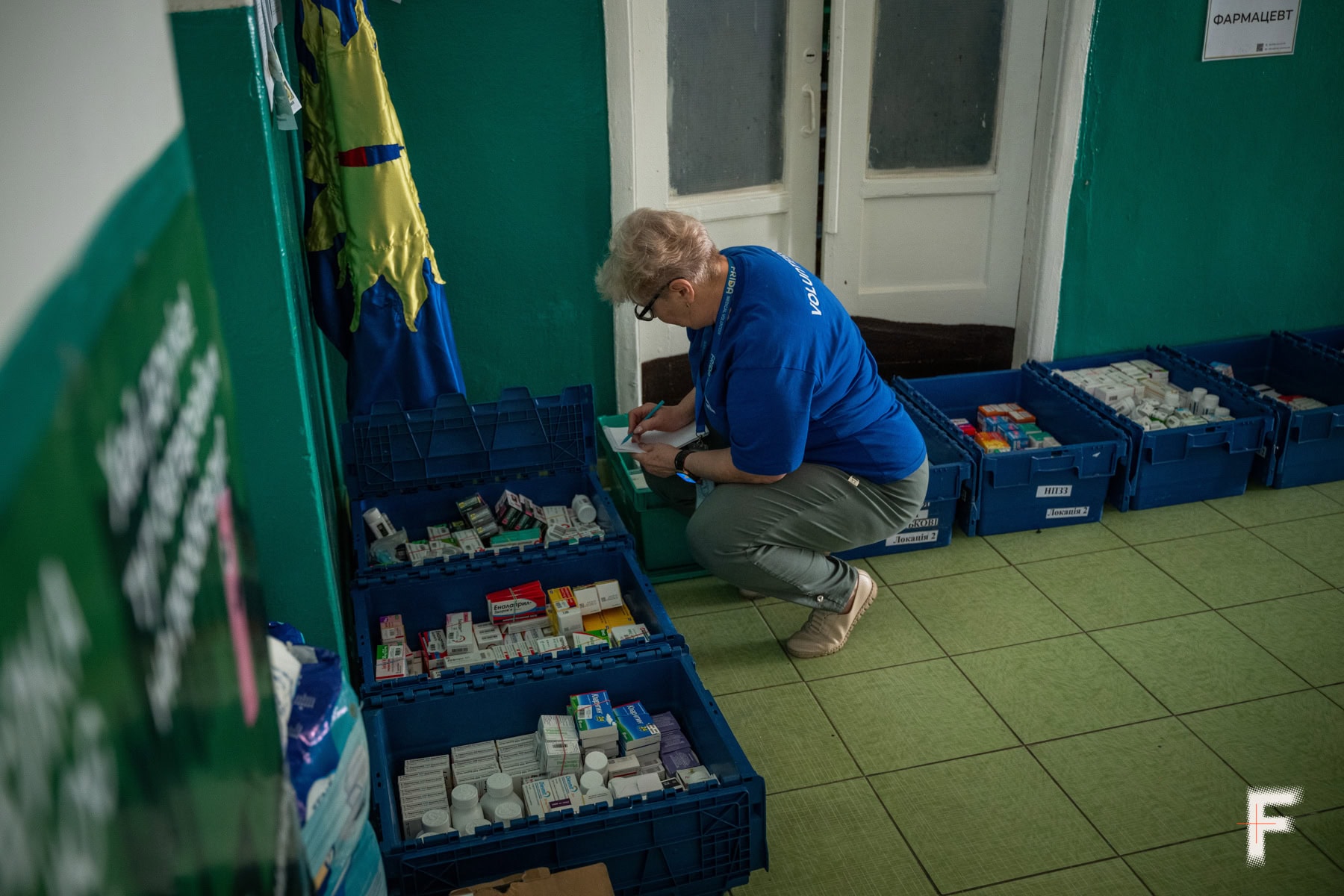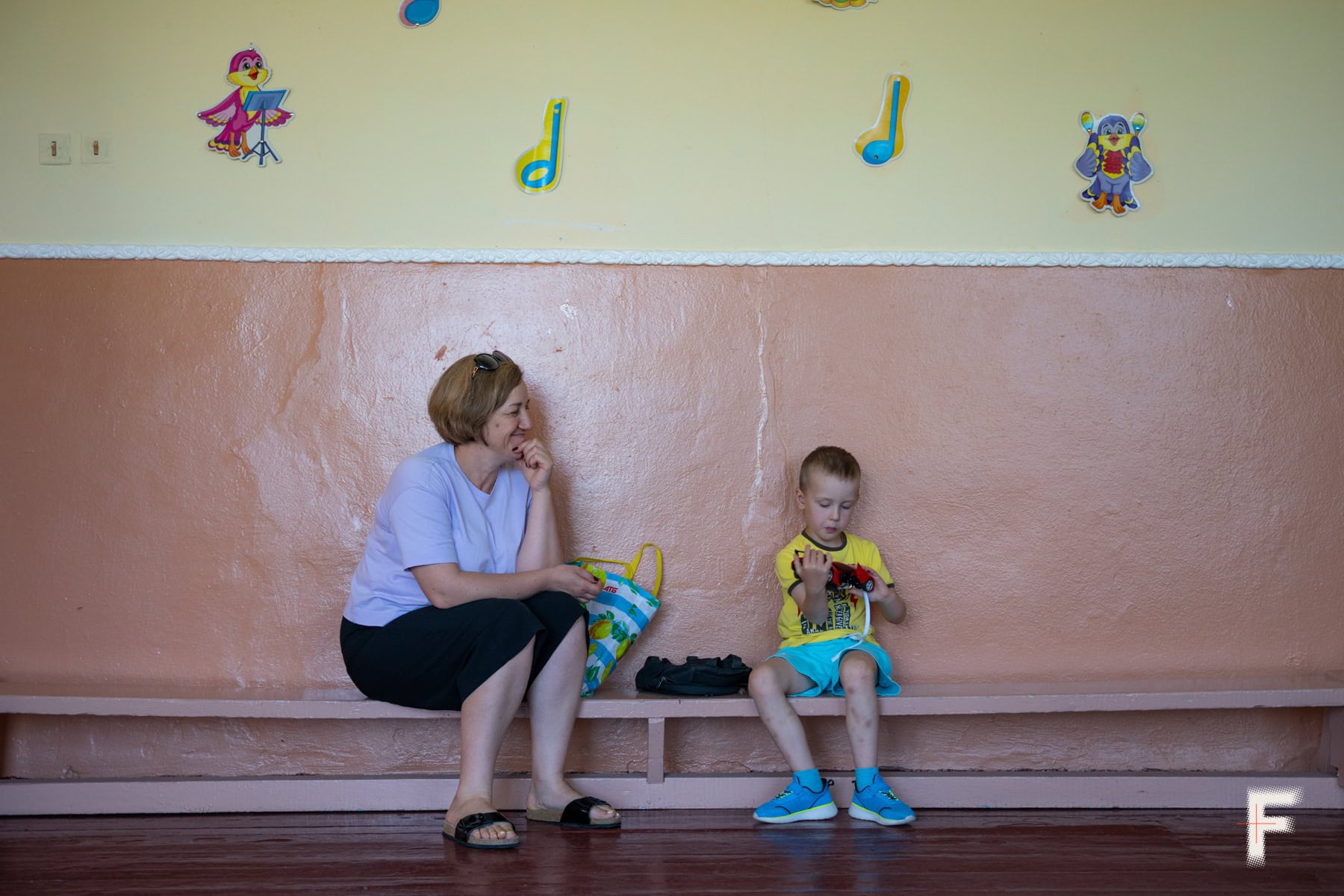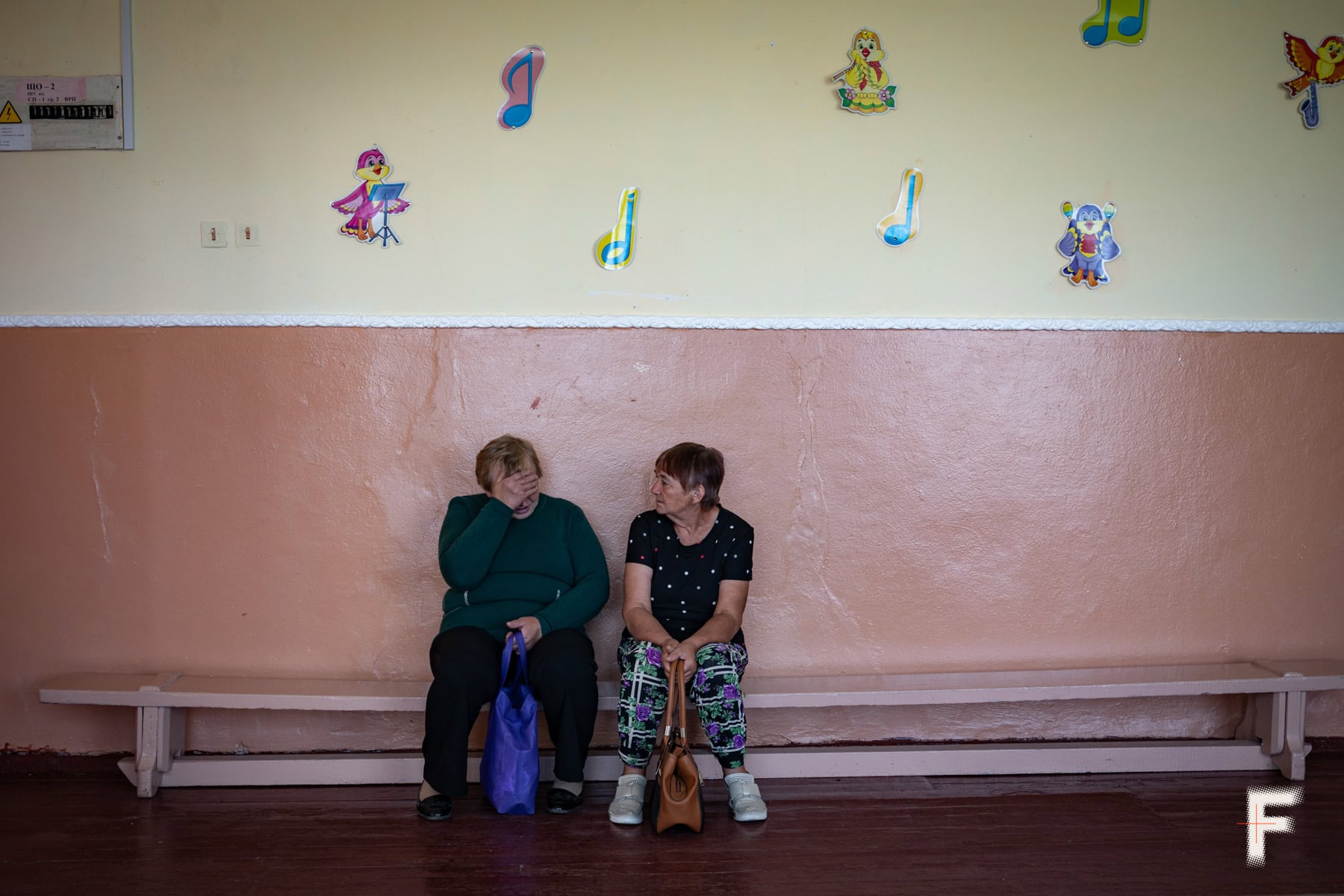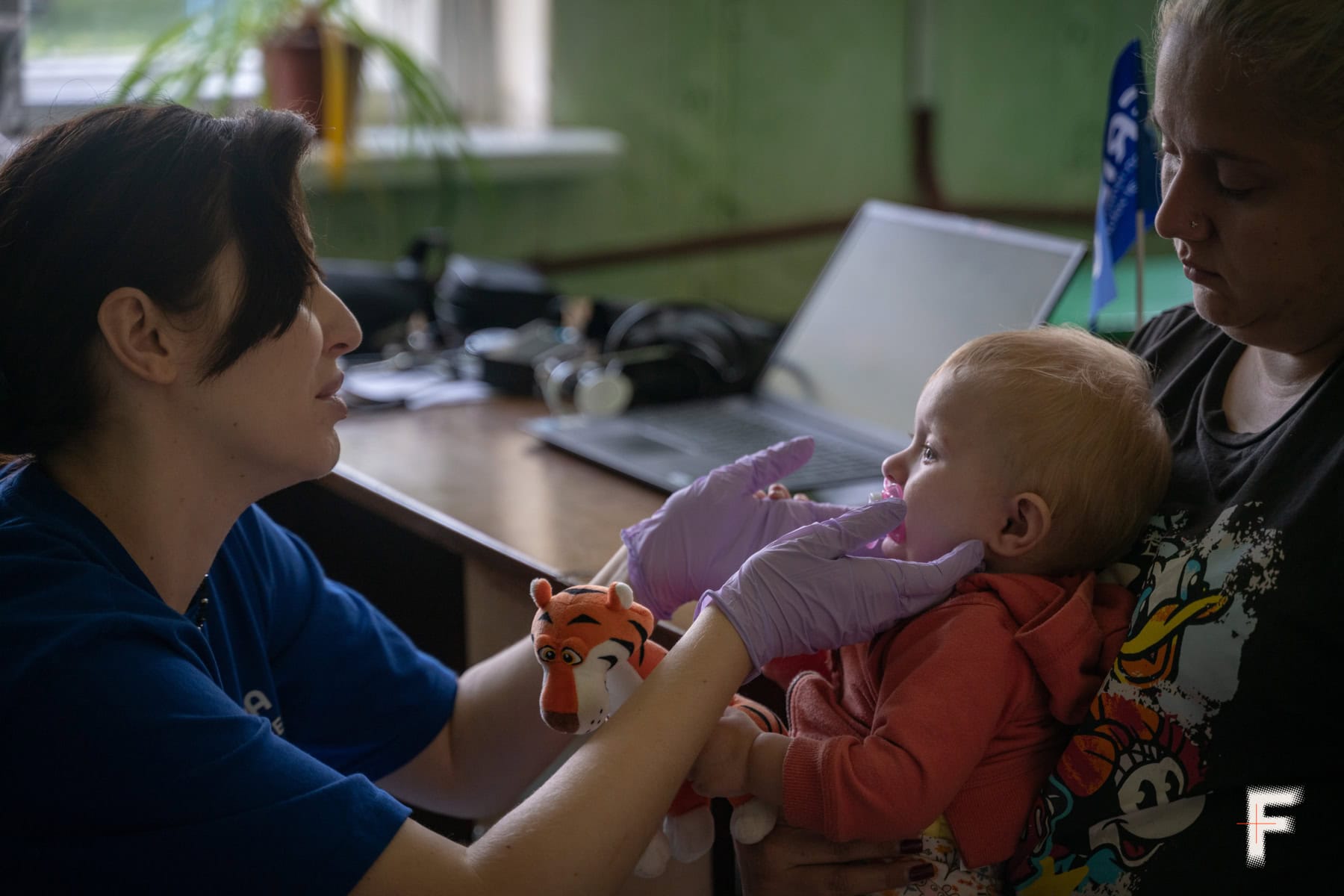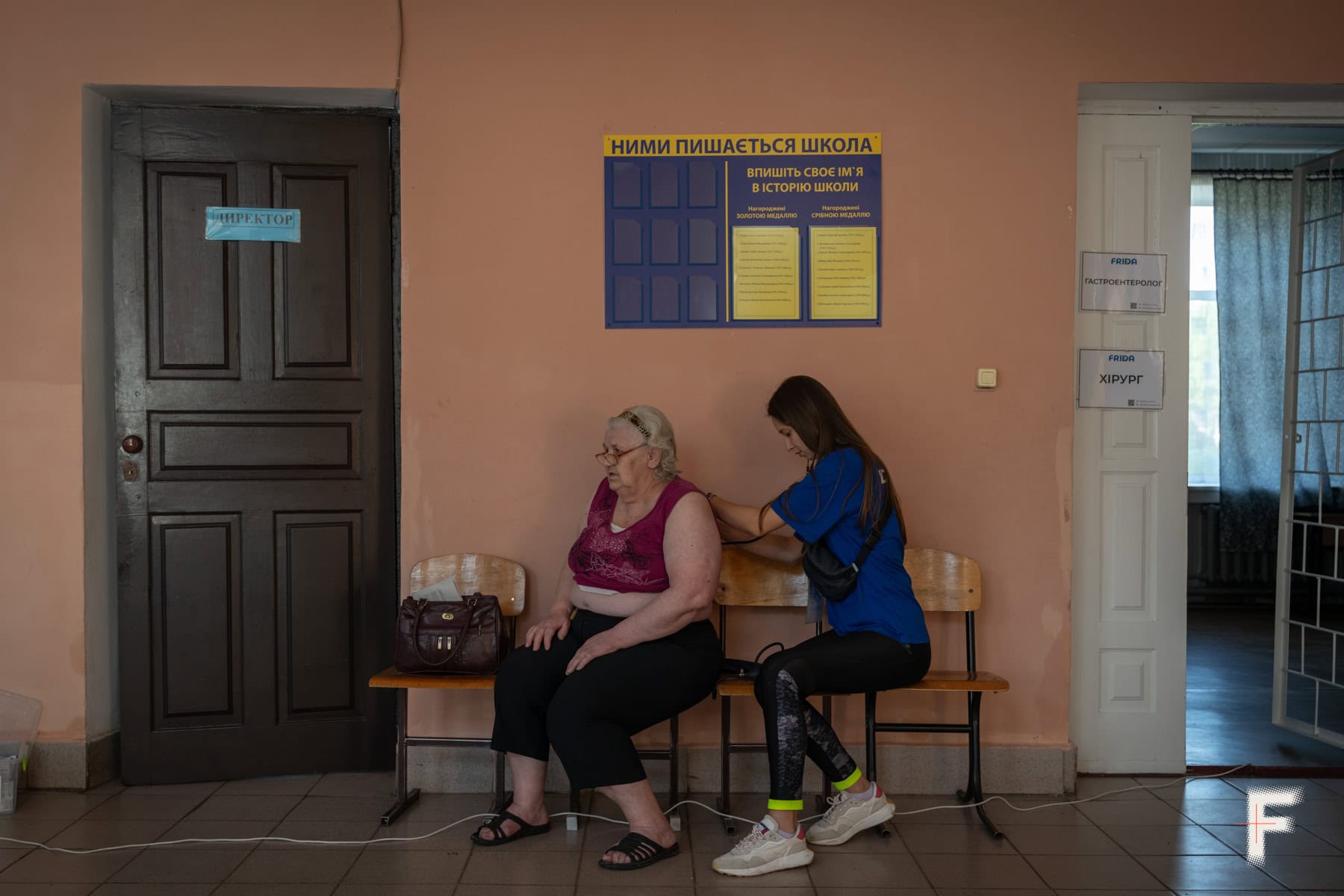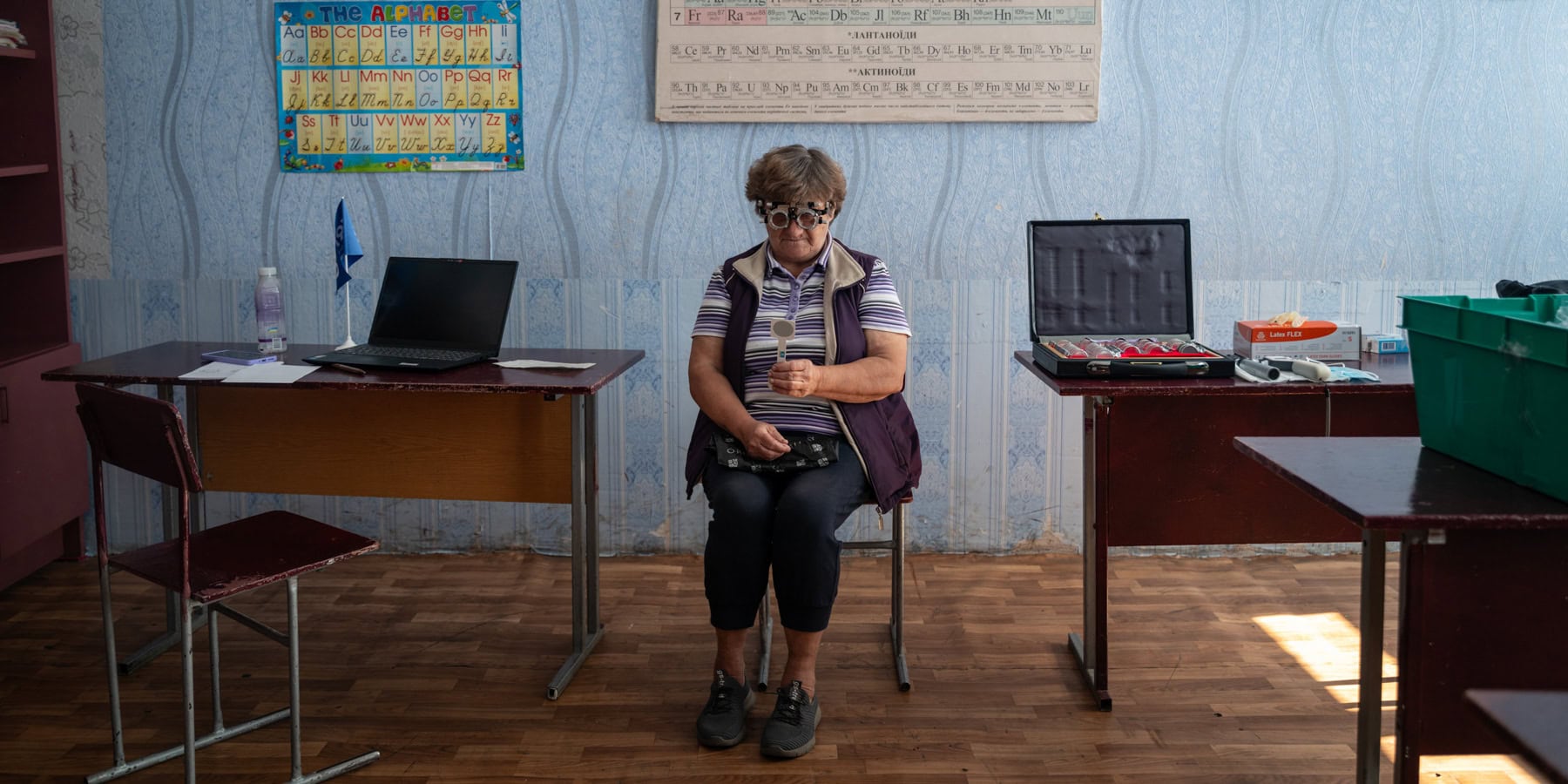

“I’m here so people don’t feel abandoned” – volunteer medics from Kyiv step in to provide aid to frontline regions.
Medics from Kyiv travel hundreds of kilometers to help civilians in villages of frontline regions where there is no access to quality healthcare. They believe that those who decided to stay have the same right to medical care as everyone else. For them, this mission is not only a professional duty – it’s also a way to stay connected to their homes under occupation, which most of the doctors had to leave behind when moving to Kyiv. Frontliner spent two days with the medics in the border villages of the Sumy region.
A full bus of medics leaving the Kyiv region fills with the sound of people clapping. The team’s mission briefing begins. The field captain, therapist Iryna Vlasenko, gives instructions:
“Those responsible for patient registration – you are the first bastion in our mission’s fortress. Find out what is bothering them and then sort people strictly by their complaints. No more than three doctors per person. Applause! Mr. Surgeon, do ultrasounds of what is needed only, don’t scan the whole grandma or else you’ll drown in work. Applause! And for the neurologist, please sign up patients reasonably, because almost everyone has neurological complaints and we’ve only got one specialist. Applause!” Each time Iryna calls for applause, her voice grows louder.
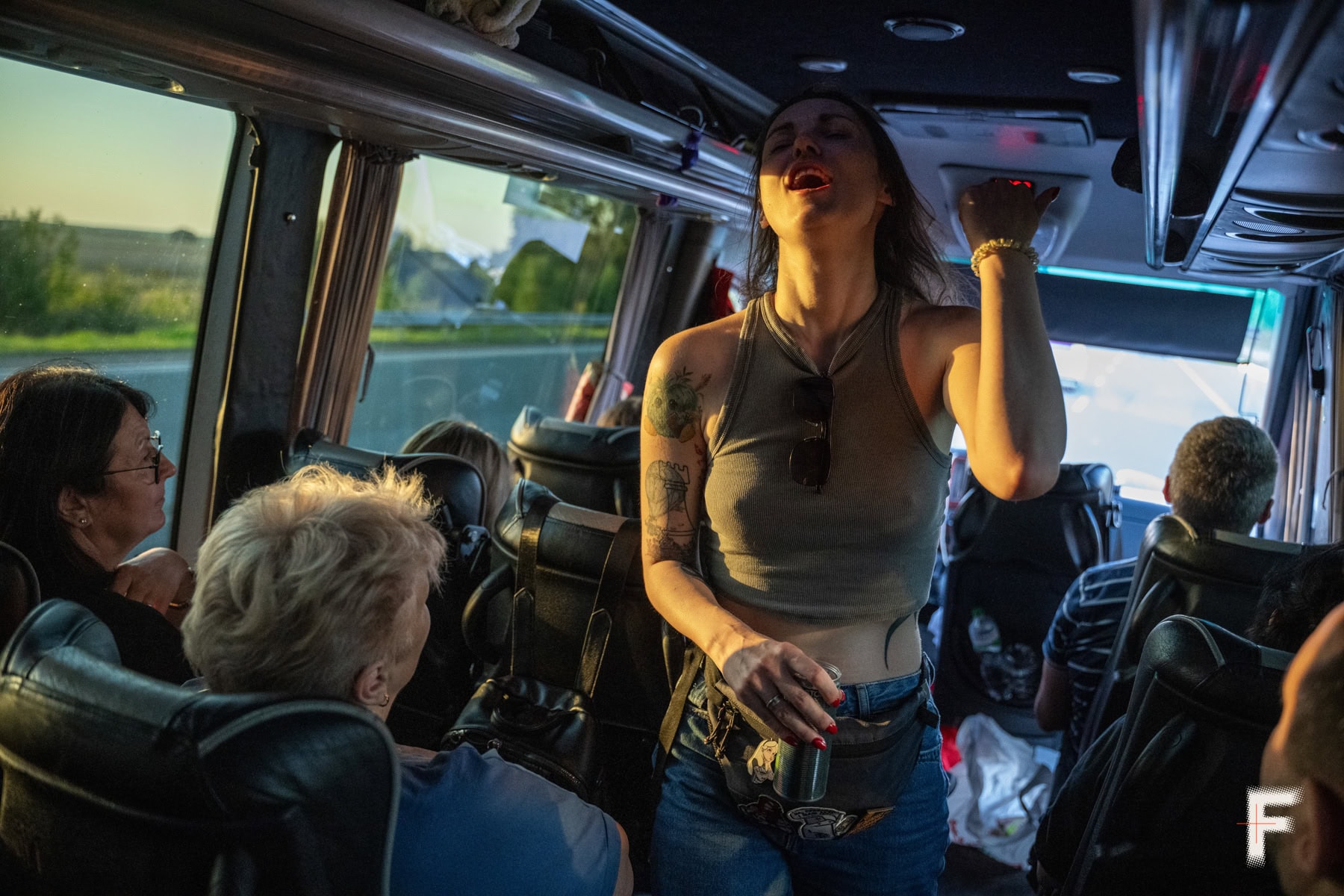

Nineteen medics are traveling in the bus. Some of them work in public hospitals, but most are employed in private hospitals in Kyiv and the surrounding areas. Every weekend, volunteers of the FRIDA mission head out to frontline regions to help civilians who lack access to quality healthcare. Most of the doctors in this mission are displaced persons from Melitopol in the Zaporizhzhia region, now under occupation, so they are familiar firsthand with the problem of limited medical aid.
This time, the mission is heading to a border area of the Sumy region, the Shostka district. There is no active fighting in this area, but Russian forces strike infrastructure daily.
After passing through dense forests that border Russia, the volunteers arrive at their lodging. Night has already fallen. Before sitting down for dinner after their long journey, they line up at the tables of the school cafeteria, forming a tunnel with their shadows. They observe a moment of silence for all the fallen defenders whose efforts make this mission possible. Only as they begin their meal do they take in the atmosphere of the dated cafeteria with its broken light fixtures and carved wooden decorations. Outside the window, the sounds of air defense can be heard on the outskirts of the village.
Mobile clinic at a school in Sumy: the care residents receive from Kyiv medics
The elementary school and kindergarten in the village of Obrazhiivka, about 50 kilometers from the Russian border, share the same building. This weekend, they are transformed into a clinic. Classrooms for primary school students become doctors’ exam rooms, and the kindergarten’s changing room is set up as an ultrasound room. Hallways are filled with a line of retirees. At registration, medical staff talk to patients to direct them to the appropriate doctors. Medications are arranged under children’s drawings in the foyer.
In the kindergarten, in the middle of a pink room with small beds, a surgeon and a gastroenterologist have set up a makeshift examination bed using school chairs. Patients are already waiting in line, seated on a low bench in the hallway. Most have been dealing with health issues for years. Local hospitals only provide treatment for symptoms, not the root causes of their illnesses; people are eager to hear what the doctors from Kyiv have to say, hoping to learn something new that might bring them relief.
Surgeon Oleksandr Kolesnyk and gastroenterologist Yurii Dushynskyi share the same perspective on their mission: those who have chosen to stay deserve access to care.
They don’t have access to good medicine, but don’t want to travel to where that access exists. But despite this, they are citizens.
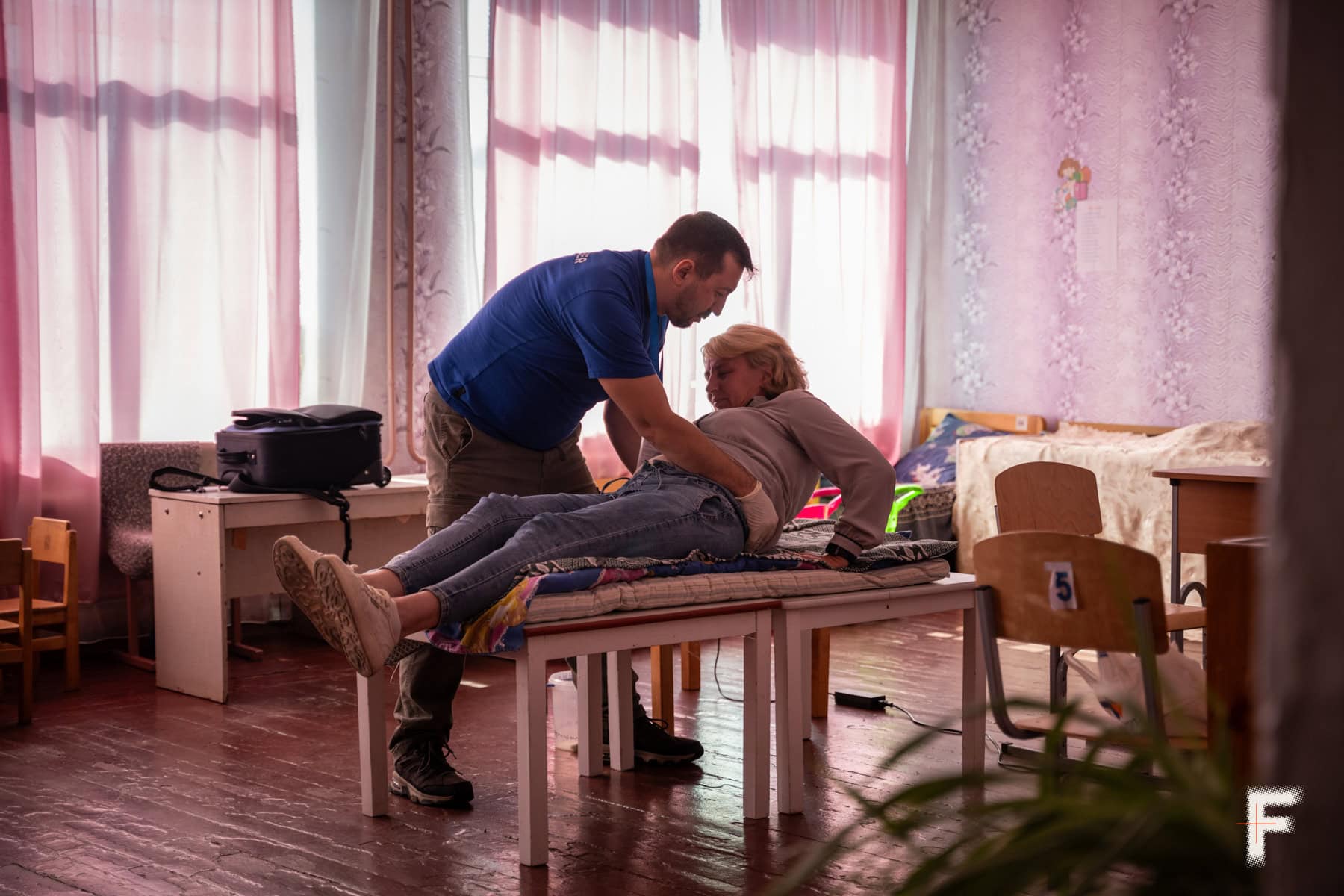

“In Kyiv, patients are more ‘spoiled’, more demanding. Here, they are still in a state where the doctor is almost royal, an authority. They don’t have access to good medicine, but don’t want to travel to where that access exists. But despite this, they are citizens, and we must provide care regardless of how they approach their own fate. They have a connection to their home, and that is not their fault,” says gastroenterologist Yurii Dushynskyi.
As soon as he started seeing patients, he immediately encountered cases of self-prescribed medications that only prolong illnesses.
“You have gastritis. I don’t see any serious symptoms at the moment, so I’ll prescribe pills. You can go to our ‘pharmacy’ there – they will give them to you for free. But whatever you’ve been taking before, do not take it anymore,” the doctor tells 53-year-old Larysa Boiko.
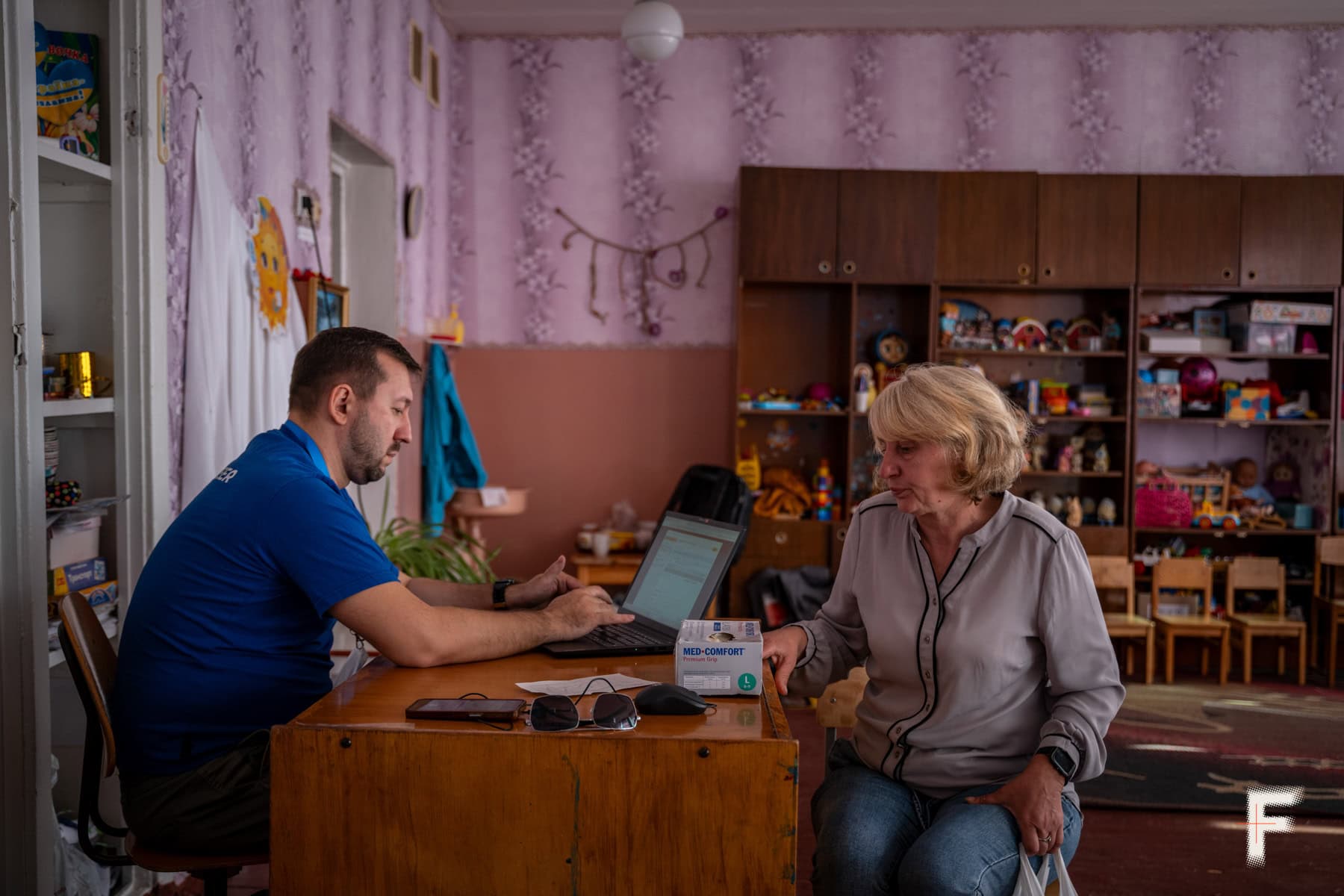

Larysa shares that the nearest hospitals where she can undergo examinations are located in Shostka, just seven kilometers from the village. However, it’s difficult for retirees to travel there and to wait in lines. They also lack the money to pay for doctor visits.
Larysa’s husband, 67-year-old Viktor Mudrak, is waiting for her in the hallway. He plans to visit half of the doctors here today. His eyesight is poor, and the stitches from a surgery continue to hurt.
Healthcare here is very challenging – there are no specialists around.
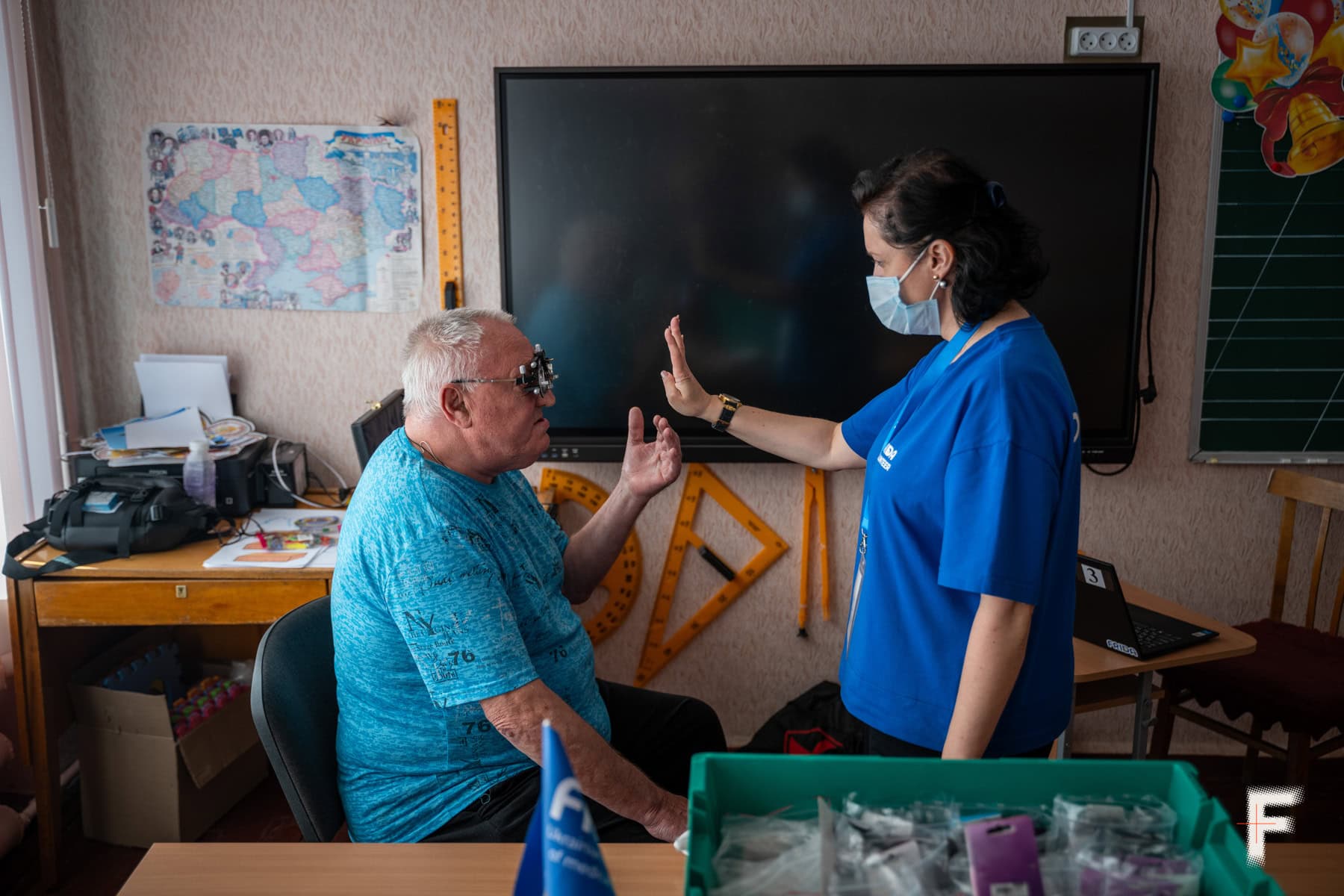

“I’ve had two surgeries on my legs. I got COVID, they put me on IV drips, gave me injections in the stomach, and that’s how I got an infection. Last year, I had another surgery, and after that, I developed a hernia. The stitches still hurt. Healthcare here is very challenging – there are no specialists around. We have to go to the family doctor. He’s good, but he can’t do everything himself. And it’s expensive,” says Viktor.
Still, he and his wife can support each other and go to a hospital, at least in more critical cases. But in the village there are people who live alone with limited mobility and haven’t left their homes in years.


“I think that people here, who came for check-ups, have even fewer opportunities to receive medical care than those in the army. No one wants to come here, no one wants to work here for their sake,” says gastroenterologist Dushynskyi.
How locals greet volunteer doctors: gratitude and queues for medicine
While the medical team actively works in school offices, captain Iryna Vlasenko keeps an eye on patients and intervenes if anyone causes a disturbance in the line. At the same time, she talks with some people who thank her for coming; she asks about village life, local authorities, and whether they have access to somewhat regular assistance.
Before each mission, the team captain contacts the local community authorities to confirm the location for the medical team to do their work and inquires about the possibility of providing water or lunch for the doctors, since no one gets paid for these missions. The doctors themselves invest their own resources to help people. According to Iryna, usually the authorities do not oppose their visits and generally allow them to see patients in schools and kindergartens, but not everyone is ready to organize food for the doctors. Despite this, the medics still go, because people are waiting for them.
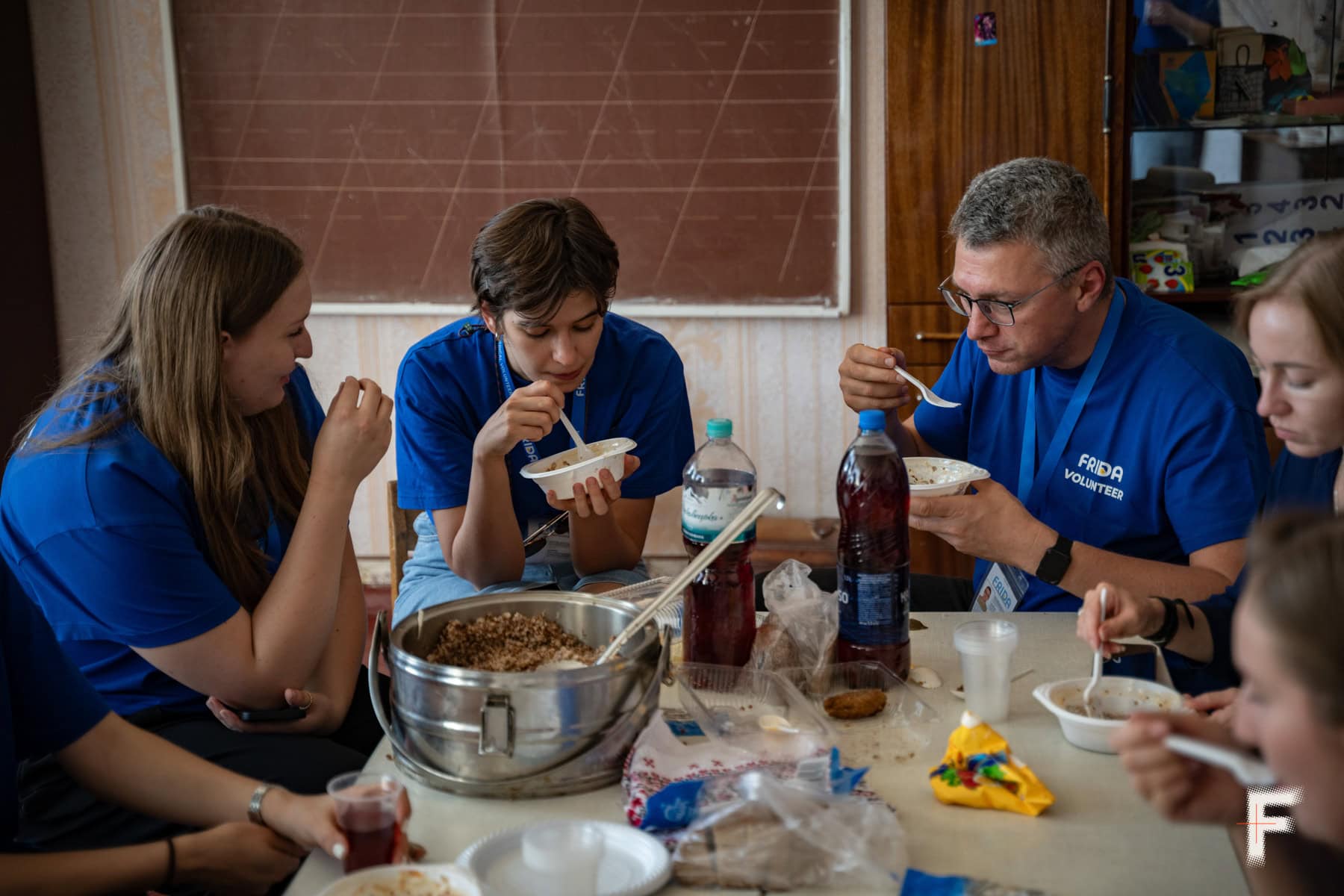

“When you live under occupation, where there is no connection, you feel abandoned. [In that environment] propaganda works hard. And I am here now so that these people don’t feel like they’ve been left behind,” says Iryna, looking at the line where many elderly women sit with lips touched up with lipstick, hair pinned up, and wearing shiny blouses. For them, the arrival of doctors from the nation’s capital is an event.
Look at these lovely grannies, even doing their hair and makeup.
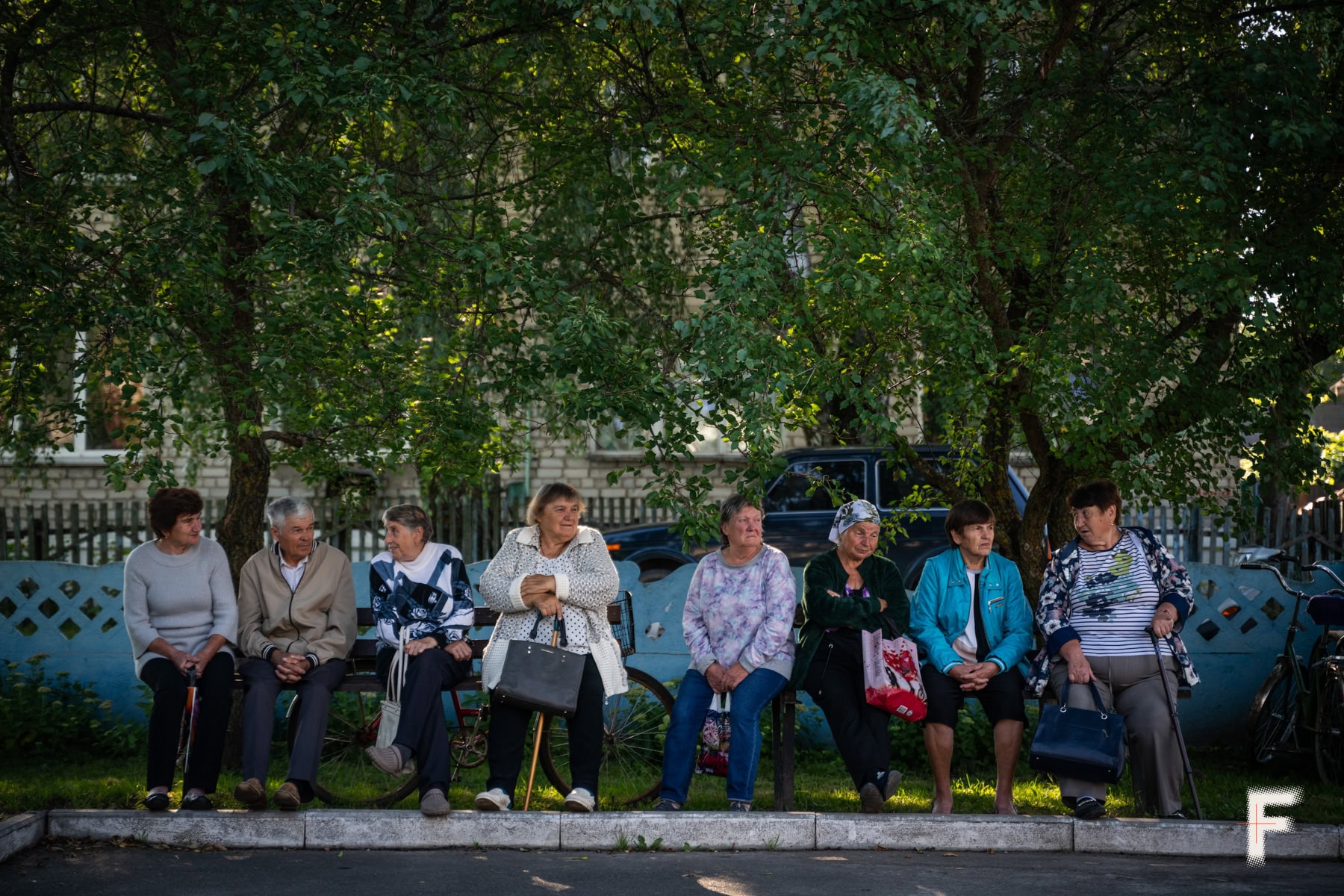

“Look at these lovely grannies – they always have their blouses clean and ironed, they wear their best clothes when coming to see us, even doing their hair and makeup,” the doctor says admiringly of her patients. In turn, throughout the day, they treat the volunteer medics warmly and even invite them to stay for dinner.
The day is filled with appointments, lingering illnesses, long consultations, and conversations, most of which take place in the smoking area by the school entrance. Both the medics and the patients, who find the queues exhausting, grow weary from the crowds.
Spirits can be lifted outside, near the boxes of toys that the volunteer doctors brought for the children. There, groups of the grandchildren of those waiting for appointments unpack the gifts and play with them.
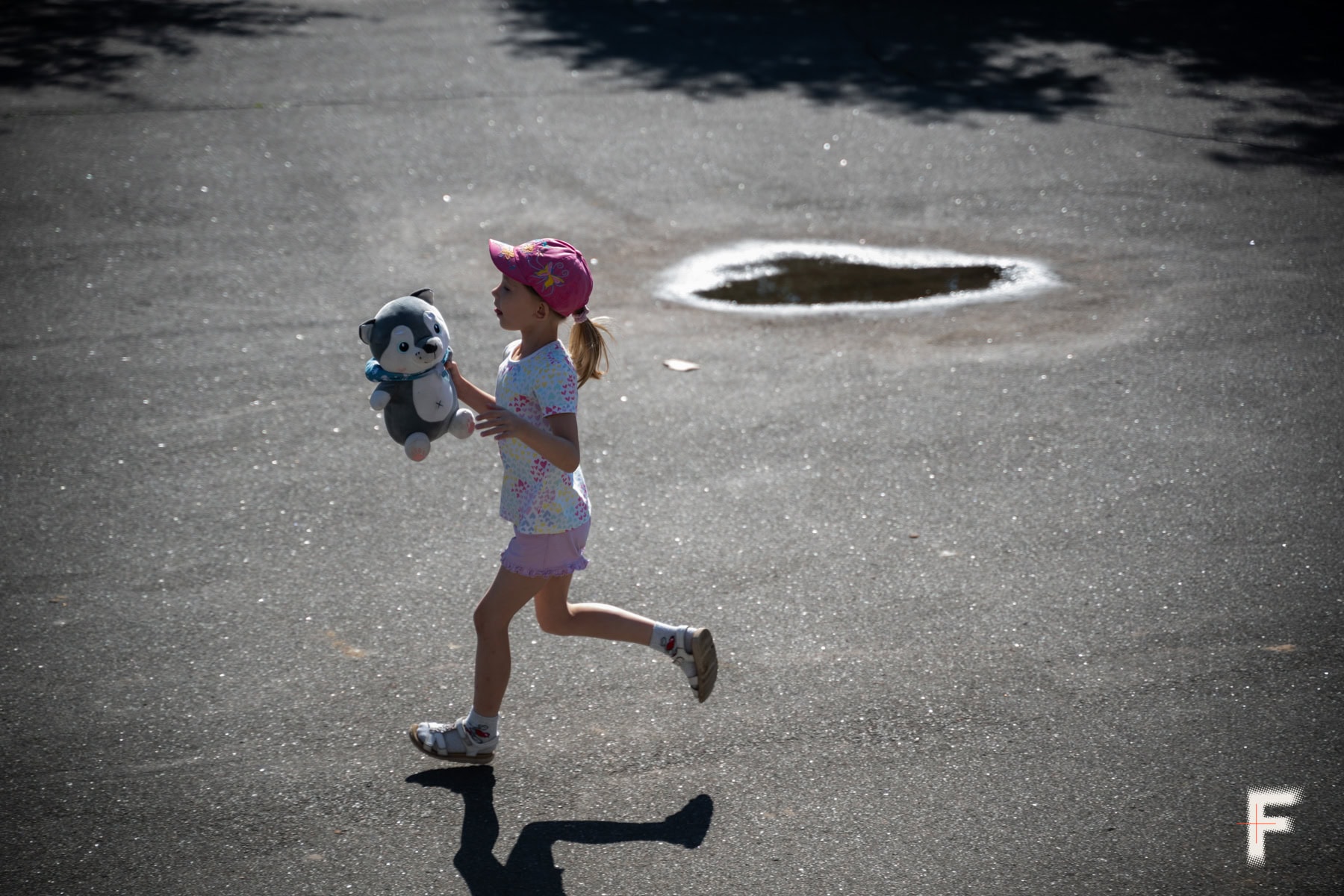

Occasionally, medics and patients step outside for a smoke break, joke around, playing with some of the toys. But there is little time for jokes or rest.
Fifteen years of treatment for a non-existent osteochondrosis: a story from a border village
Gradually, the queues at most of the offices thin out, but a crowd still waits for neurologist Kateryna Kyrychenko. Most patients have neurological issues, and many cases are advanced.
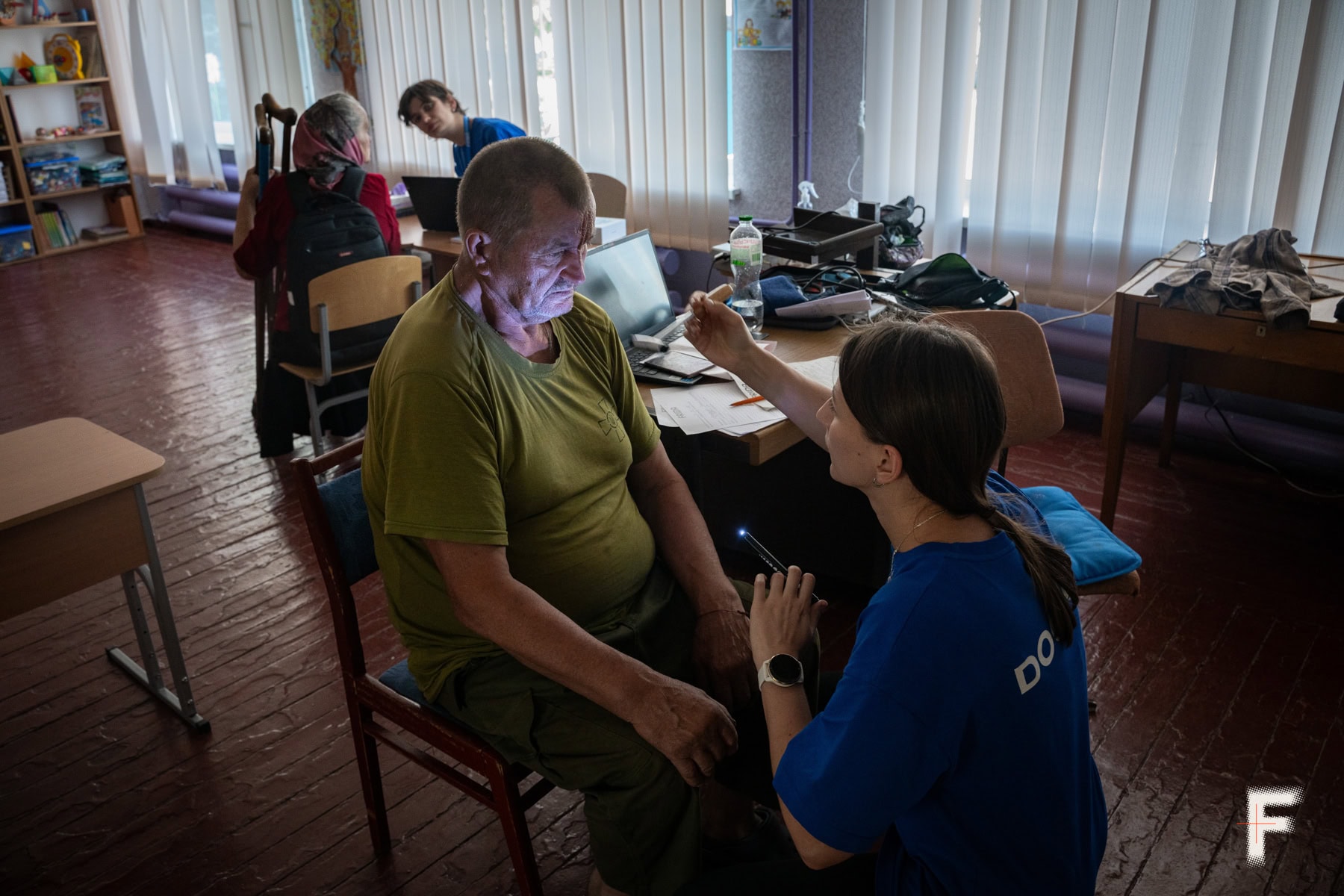

The last patient, number 111, is no exception. For 15 years, medical facilities in the Sumy region treated the man for a non-existent case of osteochondrosis, when in fact he needed an antidepressant. Somehow, this went unnoticed by everyone before.
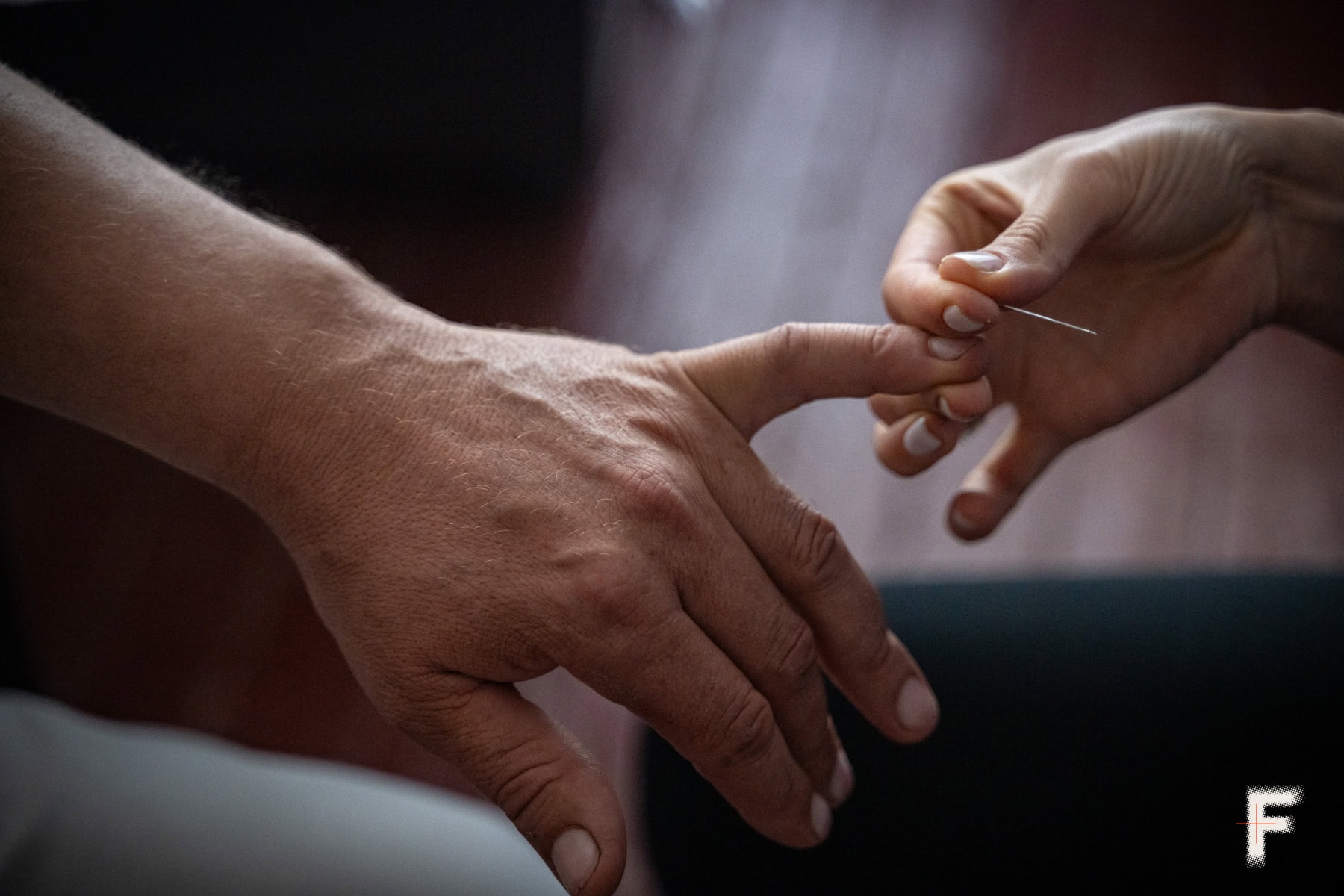

If I lie down, everything hurts. I have to keep moving all the time.
Forty-six-year-old Volodymyr Lebediev has been receiving injections prescribed by local doctors since 2008. The advanced stage of his neurological condition has rendered him unable to walk or eat comfortably, causing pain throughout his body.
“I contacted the Ministry of Health, called the hotline, saying I couldn’t endure 15 years of treatment with no results. And most of it was at my own expense: an MRI of the brain costs 2,200 hryvnias [about $60], a knee joint scan another 2,200, plus medications out of my own pocket. I came today to broaden my view, but I don’t expect to hear anything new,” the man says.
Over a decade and a half, Volodymyr’s medical records have grown thicker than the palm of his hand. He even keeps a separate folder for X-rays to fit them all.
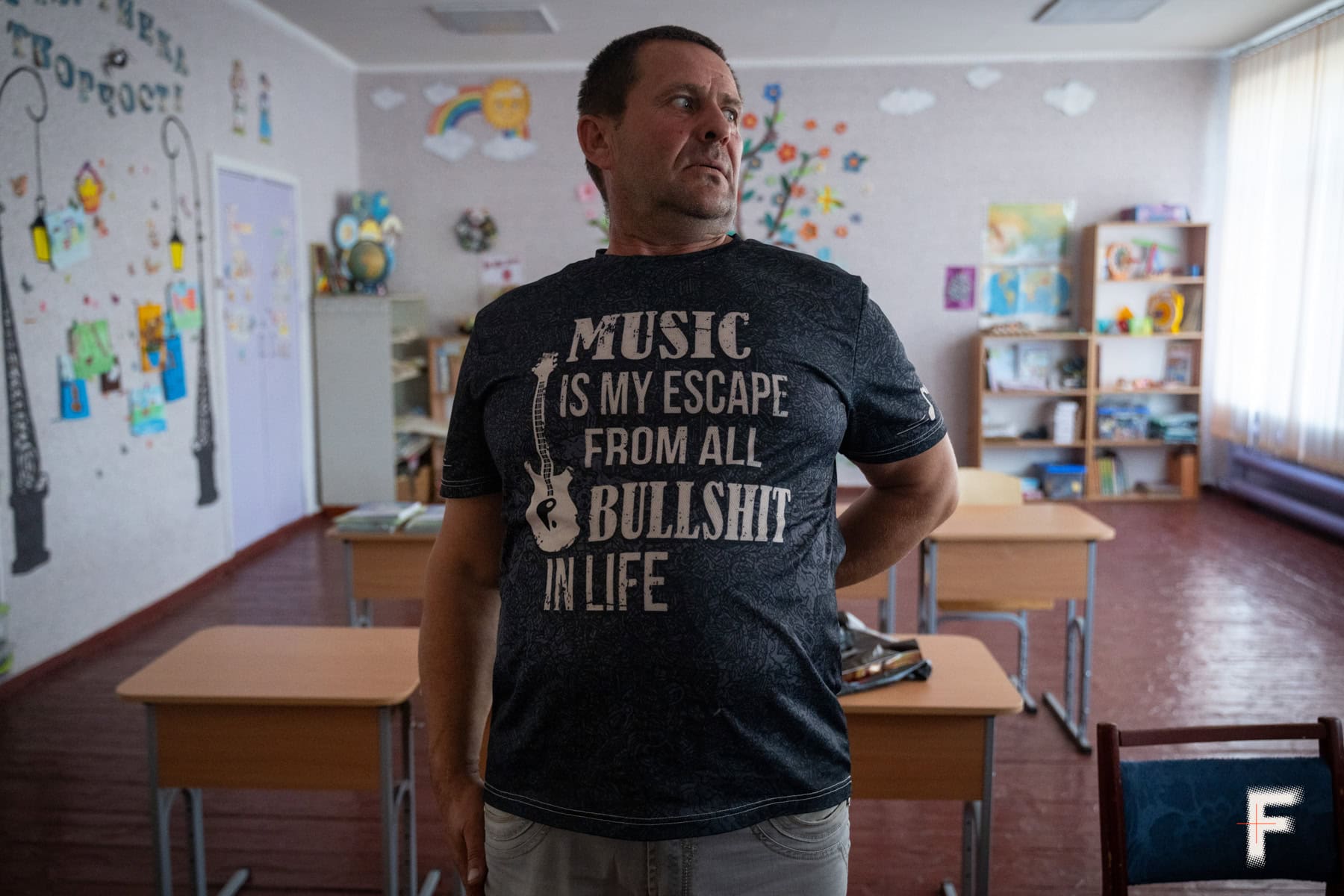

“If I eat, everything swims before my eyes and my blood pressure goes up. Last December, it reached 250. If I lie down, everything hurts. I have to keep moving all the time. If I don’t, it is all over for me,” the patient complains. Despite the persistent pain in his body, Volodymyr works physically – polishing granite.
The doctor asks him to demonstrate the movements he usually makes while doing this work.
The man stands up from the chair, raises his hands as if holding an angle grinder, and begins moving from side to side.
“And what would happen if you bent lower?” Kateryna asks.
“I wouldn’t bend, it would hurt my lower back, under the shoulder blade, and in my right leg – a deathly pain,” Volodymyr assures her. Over the years, his fear of pain has grown into panic.
Volodymyr was prescribed an antidepressant and provided with a five-month supply free of charge. The man could hardly believe he no longer needed injections and that pills would actually help him. Overjoyed to finally hear something new after all these years, he ran out of the school to his young daughter waiting outside, exclaiming:
“Daddy will carry you in his arms now, no more injections needed,” and kissed his daughter.


The medics on their mission: most of the help they provide is moral support for patients
On the second day of the mission, the team of doctors is working in the village of Ivot, located just 30 kilometers in a straight line from the aggressor country, Russia. Fifty-seven patients have gathered here, and again it is mostly retirees.
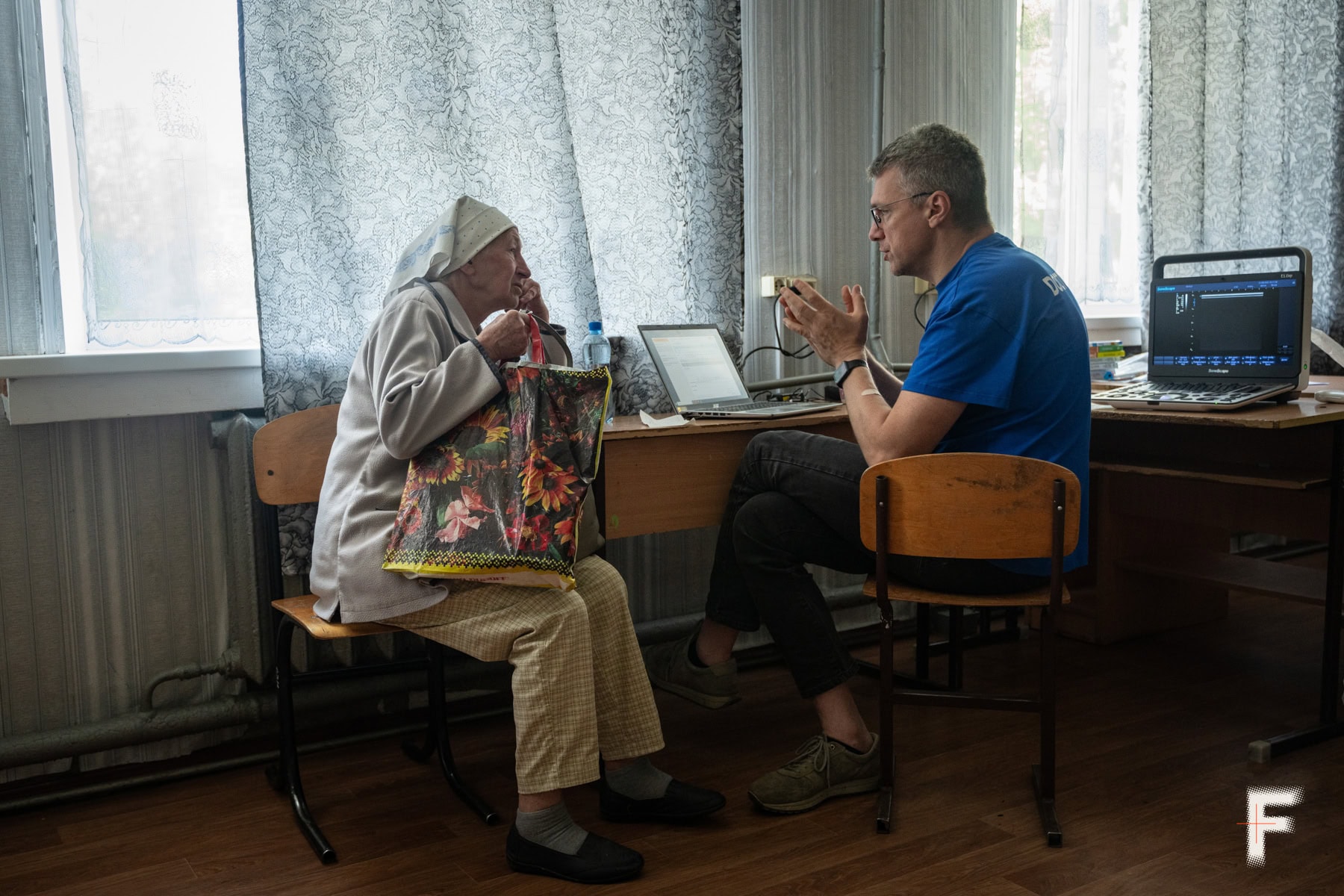

The same sort of people stayed behind in my city under occupation. Honestly, it tore at my soul that I left them, because I’m a doctor. That feeling – that I still should help someone – never goes away.
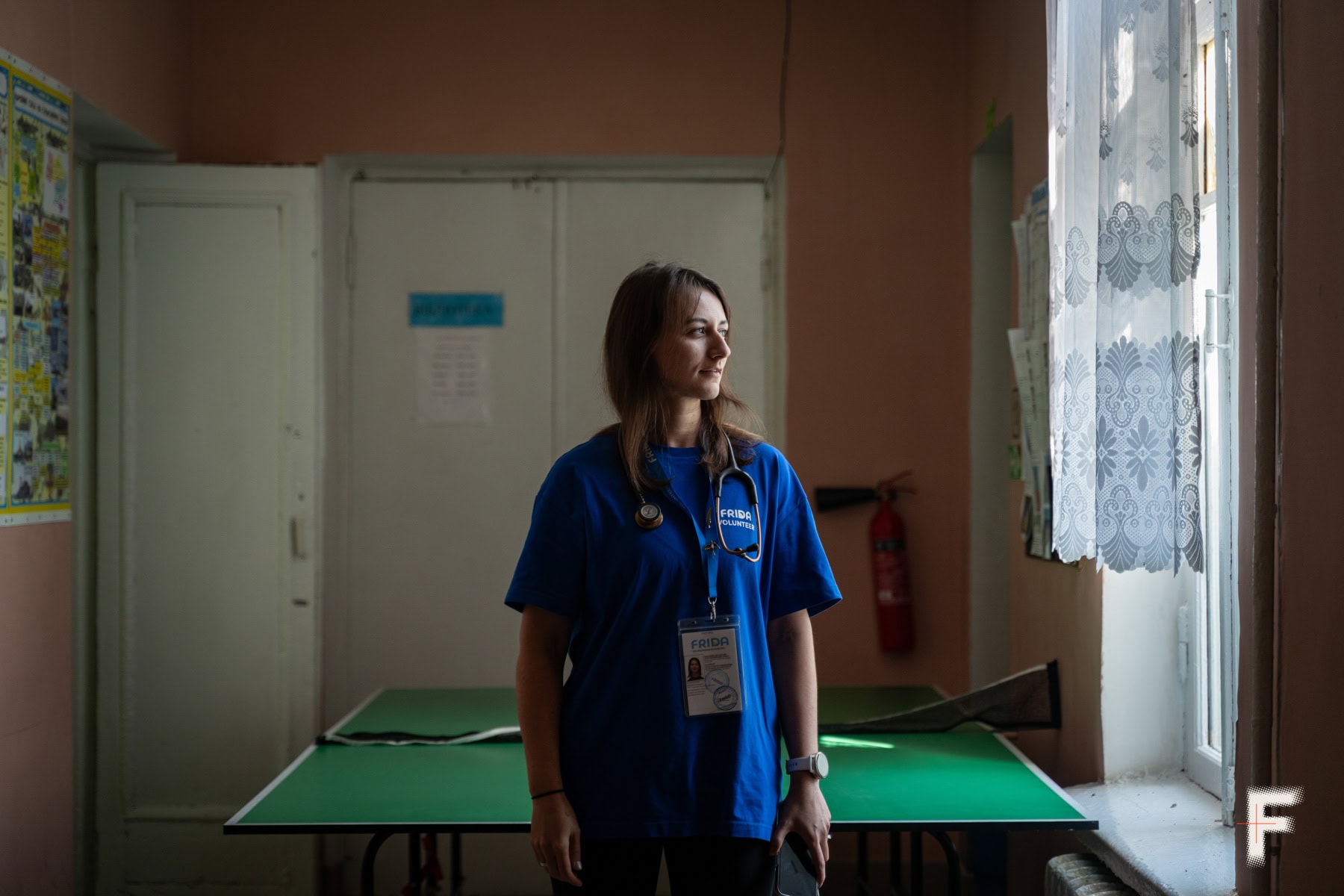

The doctor complains about the low level of public understanding of medical care in the region. Many patients react with fear to her advice about antidepressants or joint prosthetics, simply because they don’t know what those are. This, she notes, is not unique to the Sumy region.
“In reality, 70% of our work is emotional support, because you can’t help everyone quickly with treatment. The remaining 30% is physical help – giving someone the right pill, finding the right words, and the person feels better. Sometimes you make a diagnosis and prevent a heart attack, because here most people have cardiovascular diseases and untreated conditions,” says Kateryna Kyrychenko.
The second day of the mission moves faster, as this time no one had received treatment for a non-existent illness. The school in the village of Ivot looks completely different – it is a large building with many rooms and no long hallways. The atmosphere here feels homey, very unlike a hospital. There is also enough space for the queues. Even with medical appointments taking place, the classrooms don’t feel like medical exam rooms because of all the school decorations around.
And each time, I feel joy and warmth when visiting these border regions and people speak Ukrainian – it shows that all the Russian propaganda isn’t as effective as it seems.
It’s easy to tell that there aren’t many severe illnesses in this village: the boxes with medicine in the foyer are not fully unpacked. This means some medications weren’t needed, but almost all patients received vitamins.
“They are like children. They need attention, they long for a little treat. These people have had hard lives – they never knew luxury. They’re scared, because drones and rockets fly over this village. Still, they sit here and ask, ‘Will you give us vitamins?’ And each time, I feel joy and warmth when visiting these border regions and people speak Ukrainian – it shows that all the Russian propaganda isn’t as effective as it seems,” shares the mission captain, Iryna Vlasenko.
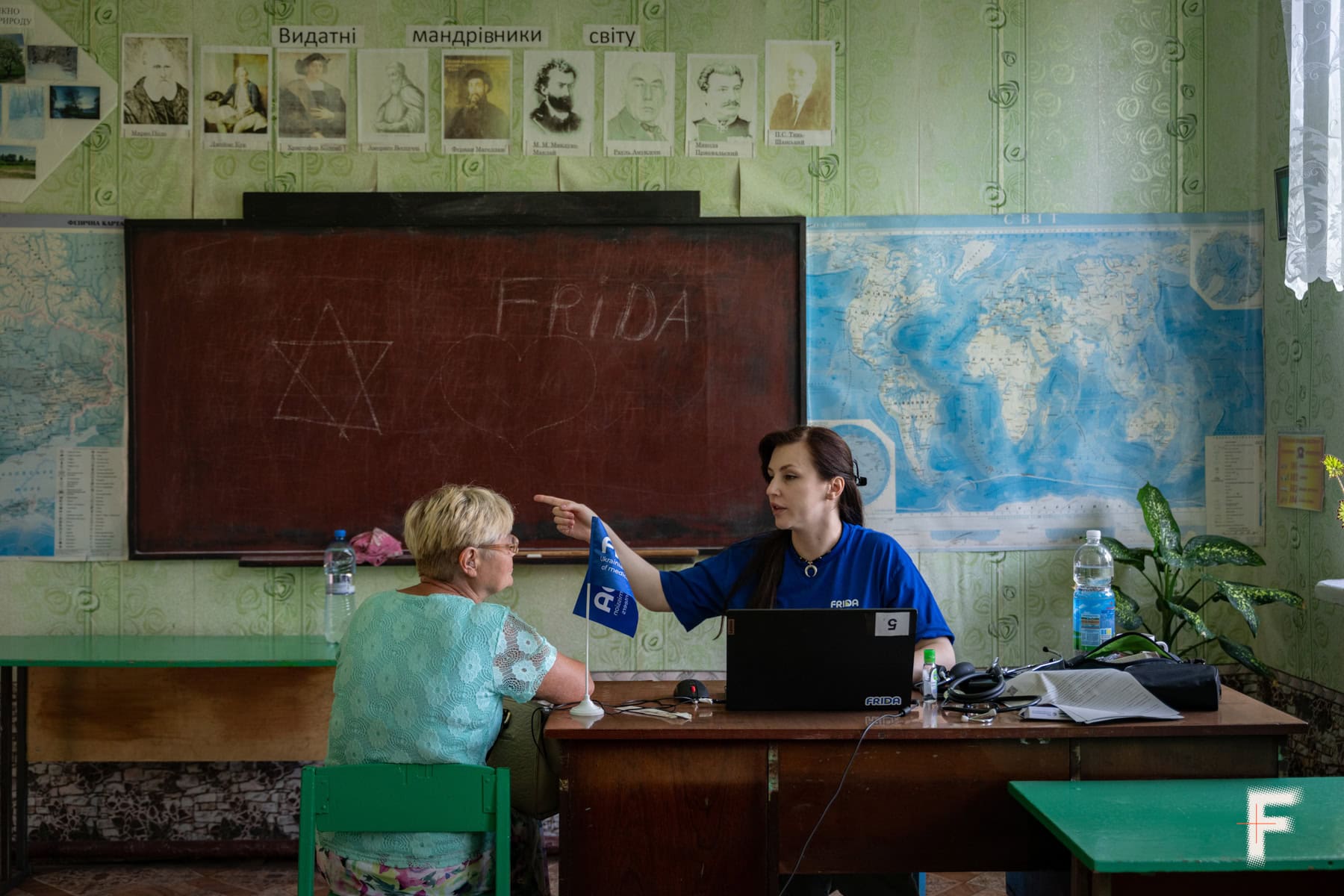

Having seen 168 patients over two days, the medical team provided 758 medical procedures, performed 126 ultrasounds, and 23 electrocardiograms. Based on the gynecologist’s findings, the doctor will continue to follow up with three patients who have malignant conditions. In addition, several patients received recommendations to undergo surgery.
Text: Albina Karman
Photos: Maksym Kishka
Adapted: Irena Zaburanna
Read more — Surgeries for Ukrainian service members that are changing global medicine

